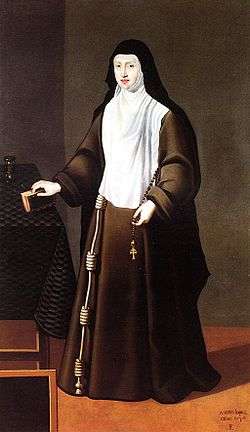Archduchess Margaret of Austria (1567–1633)
| Archduchess Margaret | |
|---|---|
 Portrait of Margaret as a Poor Clare nun | |
| Born |
25 January 1567 Vienna |
| Died |
5 July 1633 (aged 66) Madrid |
| House | House of Habsburg |
| Father | Maximilian II, Holy Roman Emperor |
| Mother | Infanta María of Spain |
| Religion | Roman Catholicism |
Archduchess Margaret of Austria (25 January 1567 – 5 July 1633), was a German princess member of the House of Habsburg.
She was the daughter of Maximilian II, Holy Roman Emperor by his wife Maria of Spain.
Life
Born in Wiener Neustadt, Margaret was the fifteenth child and fifth daughter of her parents' sixteen children, from whom eight survived infancy.[1][2] Since her early childhood, she was deeply influenced by her mother's strict Catholicism.
In 1582 Empress Maria returned to her homeland Spain permanently, taking her youngest surviving child Margaret with her, promised to marry Philip II of Spain, who had lost his fourth wife, her sister, Anna of Austria, in 1580. Margaret finally refused and took the veil under the name of Sister Margaret of the Cross as a Poor Clare nun in the Monastery of Santa Clara de las Descalzas Reales in Madrid, where she died aged sixty-six. Margaret was buried in her convent.[3]
Ancestry
The ancestry back to Maximilian I, Holy Roman Emperor, spanned 5 generations.[1]
References
- 1 2 Marek, Miroslav. "Complete Genealogy of the House of Habsburg". Genealogy.EU.
- ↑ Genealogy Database by Daniel de Rauglaudre
- ↑ Cárdenas, Fabricio (2014). 66 petites histoires du Pays Catalan [66 Little Stories of Catalan Country] (in French). Perpignan: Ultima Necat. ISBN 978-2-36771-006-8. OCLC 893847466.
- ↑

- ↑ Wurzbach, Constantin, von, ed. (1861). "Habsburg, Philipp I. der Schöne von Oesterreich" (in German). Biographisches Lexikon des Kaiserthums Oesterreich [Biographical Encyclopedia of the Austrian Empire]. 7. Wikisource. p. 112.
- ↑

- 1 2 Press, Volker (1990), "Maximilian II.", Neue Deutsche Biographie (NDB) (in German), 16, Berlin: Duncker & Humblot, pp. 471–475 ; (full text online)
- 1 2 3

- 1 2 Vladislas II, King of Bohemia and Hungary at Encyclopædia Britannica
- ↑ Boureau, Alain (1995). The Lord's First Night: The Myth of the Droit de Cuissage. Translated by Cochrane, Lydia G. The University of Chicago Press. p. 96.
- ↑ Cazacu, Matei (2017). Reinert, Stephen W., ed. Dracula. Brill. p. 204.
- ↑ Noubel, P., ed. (1877). Revue de l'Agenais [Review of the Agenais]. 4. Société académique d'Agen. p. 497.
- 1 2 Charles V, Holy Roman Emperor at Encyclopædia Britannica
- 1 2 Wurzbach, Constantin, von, ed. (1861). "Habsburg, Maria von Spanien" (in German). Biographisches Lexikon des Kaiserthums Oesterreich [Biographical Encyclopedia of the Austrian Empire]. 7. Wikisource. p. 19.
- 1 2 3 4 Stephens, Henry Morse (1903). The story of Portugal. G.P. Putnam's Sons. pp. 125, 139, 279. Retrieved 11 July 2018.
- 1 2 Harris, Carolyn (2017). Raising Royalty: 1000 Years of Royal Parenting. Dundurn Press. p. 78.
- Richard Reifenscheid: Die Habsburger in Lebensbildern, Piper Verlag (2007).